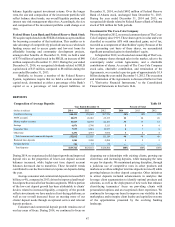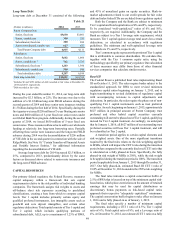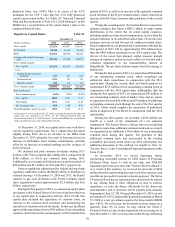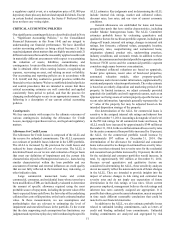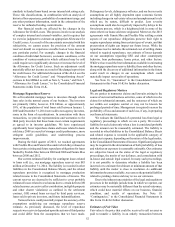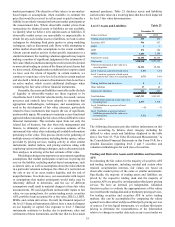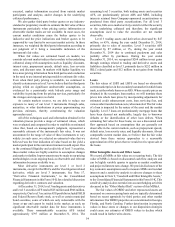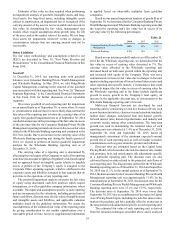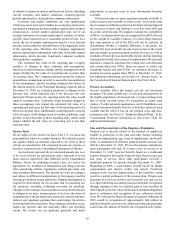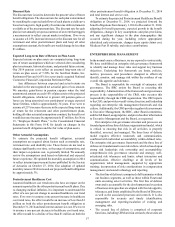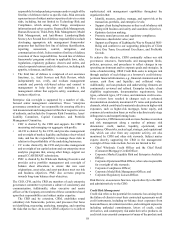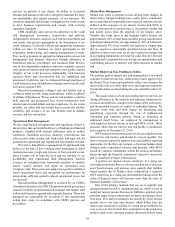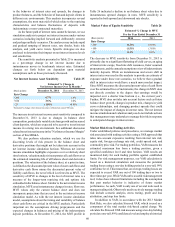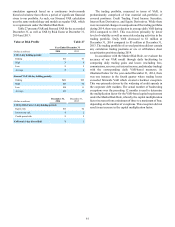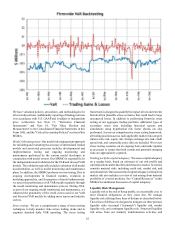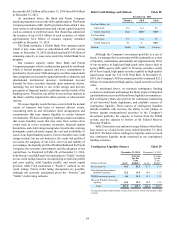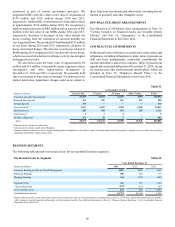SunTrust 2014 Annual Report Download - page 80
Download and view the complete annual report
Please find page 80 of the 2014 SunTrust annual report below. You can navigate through the pages in the report by either clicking on the pages listed below, or by using the keyword search tool below to find specific information within the annual report.57
Discount Rate
The discount rate is used to determine the present value of future
benefit obligations. The discount rate for each plan is determined
by matching the expected cash flows of each plan to a yield curve
based on long-term, high quality fixed income debt instruments
available as of the measurement date. The discount rate for each
plan is reset annually or upon occurrence of an event that triggers
a measurement to reflect current market conditions. If we were
to assume a 0.25% increase/decrease in the discount rate for all
retirement and other postretirement plans and keep all other
assumptions constant, the benefit cost would change by less than
$1 million.
Expected Long-term Rate of Return on Plan Assets
Expected returns on plan assets are computed using long-term
rate of return assumptions which are selected after considering
plan investments, historical returns, and potential future returns.
Our 2014 pension costs reflect an assumed long-term rate of
return on plan assets of 7.20% for the SunTrust Banks, Inc.
Retirement Plan and 6.65% for a previously acquired National
Commerce Financial Corporation Retirement Plan.
Any differences between expected and actual returns are
included in the unrecognized net actuarial gain or loss amount.
We amortize gains/losses in pension expense when the total
unamortized amount exceeds 10% of plan assets or the projected
benefit obligations, whichever is greater. All pension gains or
losses are being amortized over participants' average expected
future lifetime, which is approximately 34 years. If we were to
assume a 0.25% increase/decrease in the expected long-term rate
of return for the retirement and other postretirement plans,
holding all other actuarial assumptions constant, the benefit cost
would decrease/increase by approximately $7 million. See Note
15, “Employee Benefit Plans,” to the Consolidated Financial
Statements in this Form 10-K for details on changes in the
pension benefit obligation and the fair value of plan assets.
Other Actuarial Assumptions
To estimate the projected benefit obligation, actuarial
assumptions are required about factors such as mortality rate,
retirement rate, and disability rate. These factors do not tend to
change significantly over time, so the range of assumptions, and
their impact on pension cost, is generally limited. We annually
review the assumptions used based on historical and expected
future experience. We updated the mortality assumption in 2014
to reflect interim improvement factors published by the Society
of Actuaries on October 27, 2014. Our adoption of updated
mortality rates in 2014 increased our projected benefit obligation
by approximately 3%.
Postretirement Healthcare Cost
Assumed healthcare cost trend rates also have an impact on the
amounts reported for the other postretirement benefit plans. Due
to changing medical inflation, it is important to understand the
effect of a one percent change in assumed healthcare cost trend
rates. If we were to assume a one percent increase in healthcare
cost trend rates, the effect would be an increase of less than $1
million on both the other postretirement benefit obligation at
December 31, 2014 and total interest and service cost. If we were
to assume a one percent decrease in healthcare cost trend rates,
the effect would be a decline of less than $1 million on both the
other postretirement benefit obligation at December 31, 2014
and total interest and service cost.
To estimate the projected Postretirement Healthcare Benefit
obligation at December 31, 2014, we projected forward the
benefit obligations from January 1, 2014 to December 31, 2014,
adjusting for benefit payments, expected growth in the benefit
obligations, changes in key assumptions and plan provisions,
and any significant changes in the plan demographics that
occurred during the year, including (where appropriate)
subsidized early retirements, changes in per capita claims cost,
Medicare Part D subsidy, and retiree contributions.
ENTERPRISE RISK MANAGEMENT
In the normal course of business, we are exposed to various risks.
We have established an enterprise risk governance framework
to identify and manage these risks and support key business
objectives. Underlying this framework are limits, policies,
metrics, processes, and procedures designed to effectively
identify, monitor, and manage risk within the confines of our
overall risk appetite and tolerance.
The Board is responsible for oversight of enterprise risk
governance. The BRC assists the Board in executing this
responsibility. Administration of the framework and governance
process is the responsibility of the CRO, who executes this
responsibility through the CRM organization. The CRO reports
to the CEO, and provides overall vision, direction, and leadership
regarding our enterprise risk management framework and risk
culture. Additionally, the CRO provides regular risk assessments
to Executive Management, the BRC, other Board committees,
and the full Board, as appropriate, and provides other information
to Executive Management and the Board, as requested.
Our enterprise risk governance structure and processes are
founded upon a three line of defense organizational model, which
is critical to ensuring that risk in all activities is properly
identified, assessed, and managed. The three lines of defense
model requires effective teamwork and communication,
combined with individual accountability within defined roles.
The enterprise risk governance framework and the three line of
defense are foundational to our risk culture, which is based upon
strong risk leadership; risk ownership and accountability;
comprehensive risk governance structure and strategy; well-
articulated risk tolerances and limits; robust interaction and
communication, effective challenge at all levels of the
organization; talent management, supported by appropriate
training; incorporation of risk considerations in compensation
management; and sound technology and reporting.
• The first line of defense is comprised of all teammates within
our business segments, as well as those within Functional
units executing select activities. The first line of defense
owns and is accountable for the development and execution
of business strategies that are aligned with the risk appetite,
tolerances, and limits established by the Board of Directors,
as well as the associated processes and controls. It is also
responsible for accurate and timely identification,
management and reporting/escalation of existing and
emerging risks.
• The second line of defense is comprised of corporate
functions, including CRM and risk stewards; these units are


